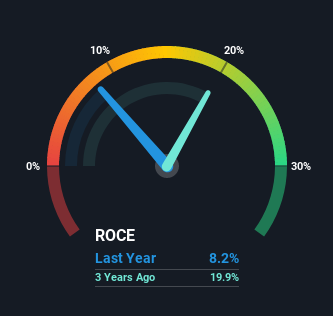Investors Could Be Concerned With FONAR's (NASDAQ:FONR) Returns On Capital
What trends should we look for it we want to identify stocks that can multiply in value over the long term? Firstly, we'll want to see a proven return on capital employed (ROCE) that is increasing, and secondly, an expanding base of capital employed. This shows us that it's a compounding machine, able to continually reinvest its earnings back into the business and generate higher returns. Although, when we looked at FONAR (NASDAQ:FONR), it didn't seem to tick all of these boxes.
What is Return On Capital Employed (ROCE)?
Just to clarify if you're unsure, ROCE is a metric for evaluating how much pre-tax income (in percentage terms) a company earns on the capital invested in its business. Analysts use this formula to calculate it for FONAR:
Return on Capital Employed = Earnings Before Interest and Tax (EBIT) ÷ (Total Assets - Current Liabilities)
0.082 = US$14m ÷ (US$185m - US$17m) (Based on the trailing twelve months to March 2021).
Therefore, FONAR has an ROCE of 8.2%. On its own, that's a low figure but it's around the 8.8% average generated by the Medical Equipment industry.
Check out our latest analysis for FONAR
Historical performance is a great place to start when researching a stock so above you can see the gauge for FONAR's ROCE against it's prior returns. If you're interested in investigating FONAR's past further, check out this free graph of past earnings, revenue and cash flow.
The Trend Of ROCE
In terms of FONAR's historical ROCE movements, the trend isn't fantastic. To be more specific, ROCE has fallen from 24% over the last five years. However it looks like FONAR might be reinvesting for long term growth because while capital employed has increased, the company's sales haven't changed much in the last 12 months. It's worth keeping an eye on the company's earnings from here on to see if these investments do end up contributing to the bottom line.
On a related note, FONAR has decreased its current liabilities to 9.2% of total assets. That could partly explain why the ROCE has dropped. What's more, this can reduce some aspects of risk to the business because now the company's suppliers or short-term creditors are funding less of its operations. Since the business is basically funding more of its operations with it's own money, you could argue this has made the business less efficient at generating ROCE.
Our Take On FONAR's ROCE
To conclude, we've found that FONAR is reinvesting in the business, but returns have been falling. And investors appear hesitant that the trends will pick up because the stock has fallen 11% in the last five years. In any case, the stock doesn't have these traits of a multi-bagger discussed above, so if that's what you're looking for, we think you'd have more luck elsewhere.
Like most companies, FONAR does come with some risks, and we've found 1 warning sign that you should be aware of.
If you want to search for solid companies with great earnings, check out this free list of companies with good balance sheets and impressive returns on equity.
This article by Simply Wall St is general in nature. We provide commentary based on historical data and analyst forecasts only using an unbiased methodology and our articles are not intended to be financial advice. It does not constitute a recommendation to buy or sell any stock, and does not take account of your objectives, or your financial situation. We aim to bring you long-term focused analysis driven by fundamental data. Note that our analysis may not factor in the latest price-sensitive company announcements or qualitative material. Simply Wall St has no position in any stocks mentioned.
Have feedback on this article? Concerned about the content? Get in touch with us directly. Alternatively, email editorial-team (at) simplywallst.com.

